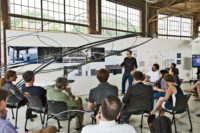Editor's Note, June 3, 2019: Stanley Tigerman has died at age 88. RECORD remembers the "Mr. Chicago," revisiting a 2015 interview with the architect about his hometown and its place in architectural culture.
The godfather of the Chicago architectural community, Stanley Tigerman, 85, has long played a historic role in the city’s practice, education, and culture. Although he went east to Yale University for his B.Arch (1960) and M.Arch (1961), Tigerman returned to his hometown in 1962 and established his office. In 1982, he and his wife, Margaret McCurry, merged their offices and renamed the firm Tigerman McCurry Architects. Through the years, Tigerman has helped connect Chicago to the architectural debates occurring in other parts of the country and internationally. In the 1970s, he began arranging exhibitions and conferences aimed at getting Chicago’s younger architects recognized in a city entrenched in the modernist legacy of Mies van der Rohe. He served as the director of the School of Architecture at the University of Illinois at Chicago from 1985 to ’93, and cofounded Archeworks in 1994, a student design program with a public service mission. Tigerman’s own architecture has been characterized by a belief in technique, the role of humor and allegory, and a commitment to social concern. Now, with the Chicago Architecture Biennial 2015, organized by the city and the Graham Foundation for Advanced Studies in the Fine Arts, opening this month, Tigerman is getting renewed attention. An exhibition of his drawings, 821 Stanley Tigerman Sketches 821, is on view at the Volume Gallery from October 24 to December 5. Last month, the architect was one of five Chicagoans in the arts singled out to receive the Fifth Star Awards from the city. Tigerman talked to Architectural Record’s editor in chief, Cathleen McGuigan, and deputy editor Suzanne Stephens about his favorite subject: Chicago.
Architectural Record: You’ve often said that you believed in Chicago and that it was important to have roots there, even though you’ve designed buildings elsewhere. What gave you that sense of commitment to Chicago?
Stanley Tigerman: I was born here. I’m of an age when very young architects sometimes ask me, “When do you go out and open your own practice? And where do you practice?” My answer is, when you’re no longer capable of taking instructions from another architect, you should open your own office. And where? You should go home. Now, I suppose that sounds simplistic, since Chicago is just a great city of modernism—yet it is my home.
It’s not important where you’re from, but you need to go home. Going home shows an allegiance that will be returned in kind by your city, by the city government, by the powers that be. My coming home after Yale has long since paid off. I wasn’t born on the right side of the tracks, but it doesn’t make any difference. You show your loyalty to your place of birth, and it will pay you back in spades.
But why, when you studied architecture, did you go east?
I had no choice. IIT was a monastery, a seminary for seminarians who were believers in the Mies idiom and his way of doing things. It was not open to people like me.
I started at M.I.T., flunked out after one year and spent the next 10 years in the wilderness, working for any number of architects, good, bad, and indifferent, and then finally found my way to Yale, where I thrived. I was older and less willful, less spoiled. Paul Rudolph [then chair of the department of architecture] practically invented me out of whole cloth.
When I got my master’s, Rudolph asked me to stay and work in his office in New Haven. I said, “Mr. Rudolph, do you see that tan Ford Falcon station wagon with smoke belching from its exhaust pipe? I have to get in that car and head back to Chicago right now, or I’m going to be physically ill.”
I would not have thrived in Paul’s office or on the east coast. You know, I don’t give a shit about New York. I’m a Chicago booster, like Saul Bellow or Nelson Algren.
So when Chicago shines, in terms of the Biennial now, with [curators] Sarah Herda and Joe Grima getting 100 or so firms from six continents here for it, that’s pretty fantastic. They’re very young. Many of them are frankly brilliant and are doing things that I think are pretty terrific. So I’m thrilled.
The Biennial gives credit to the attention you focused on Chicago in 1977 with a conference at the Graham Foundation called the State of the Art of Architecture.
The year before, you formed a group of architects, “the Chicago Seven,” that included Tom Beeby, Ben Weese, Jim Freed, and Stuart Cohen, and mounted a show of your and their work to protest the 100 Years of Architecture in Chicago exhibition at the Museum of Contemporary Art. What was all this about?
After we did the Chicago Seven exhibition, we had the mosh pit [the 1977 conference] with all these architects from New York, Los Angeles, and here. We had the Whites, the Grays, the Silvers, and the Chicago Seven. There was a lot of antagonism from the Miesians in Chicago, of course—this was a challenge to them. We, the Chicago Seven, didn’t have much in common, and we didn’t even like each other. But what we wanted was a place at the table.
As the impresario for both the show and the conference, you focused on all the design ferment going on nationwide. Did it bring enough attention to design innovation in Chicago, versus the east and west coast?
Yes and no. What did happen is that we started speaking to each other across the country. Bob Stern, Peter Eisenman, and Frank Gehry and I talked and became really good friends as a result of these events. Paul Rudolph did this at Yale by inviting people that he couldn’t care less about—Gordon Bunshaft, Mies, and Craig Elwood. I mean, he hated all those people, with the exception of Mies, of course. But having them in New Haven was a way of confronting his own beliefs, in a way.
You have been Mr. Chicago—the glue bringing all these ideas and architects together. And it’s still true. Is this because of your particular personality and sensibility or something about being from Chicago, or both?
Well, it’s actually both. It’s in my nature to pass the baton. So you’ll find that the youngest generation—the generation behind Jeanne Gang and John Ronan, but including them as well—is very supportive of me, as I am of them, because I feel that part of our obligation is to pass the baton. But it is also about Chicago. I’ve always said New York is a place of perpetual intellectual foreplay—they never get it on; they just talk. I believe in acting. Archeworks, which [designer] Eva Maddox and I started in 1994, could only have happened in Chicago at that time.
At Archeworks, with students working on pro bono projects, you were really ahead of your time—you started it long before Architecture for Humanity, for example. And though you’re no longer with Archeworks, you have brought that ethical sensibility from your office to such projects as the Educare day-care center at the Robert Taylor Homes (2000).
And there’s my Pacific Garden Mission for the Homeless [Chicago, 2007]. Also, I love all the symbolism I did at the Holocaust Museum [Skokie, Illinois, 2009]. You know, I am of an age where, if you don’t give back, you have to ask, what is the purpose of it all?
Let’s go back to Mies. You knew him, and, despite your different ideas about architecture, you liked him.
I admired him like crazy. OK, I’m Jewish, but architecturally he was my Abraham. And he had a fabulous sense of humor. And he was also a very human guy—a mensch.
Yes, but unlike Isaac, you tried, figuratively, to deep-six Abraham—or at least his influence. Your move into postmodernism was epitomized by your famous Titanic collage showing Mies’s Crown Hall sinking into Lake Michigan (1978).
It’s interesting that you bring that up, because the Chicago Architectural Club for years has put on a Burnham Prize Competition. This year they’re asking young people to come up with an iconic image much like the one I did then. And they’ve asked me to also do a post-Titanic collage.
What do you think about some of the Chicago architects active today, such as Adrian Smith and Gordon Gill?
They’re terrific. Whatever one’s feelings about supertall buildings, there’s no question [Smith and Gill] do incredibly innovative work with tall buildings, as does Jeanne Gang. Jeanne’s doing a fabulous building [Wanda Vista, page 91], for this Chinese developer. It’s a beautiful, conceptually brilliant thing, in the way that John Ronan’s Poetry Foundation is.
You’ve talked about how great you think this next generation of young architects is. What characterizes them and who are some you really like?
When you pass the baton in some serious way, it’s the right thing—you assure your own continuity.
One young woman from Yale who used to be in our office, Erin Beslar—I called her Spike because she had this spiky red hair—is really interested in making things. There’s a firm in Chicago called PORT Urbanism [page 106], which has done a scheme for reimagining the lakefront here.
And for drawing, look at Jimenez Lai [founder of Bureau Spectacular]. But this youngest generation is no longer becoming registered and joining the AIA. They need to find their own ways to build. Ultimately you want building.
Yes. You have said Chicago is more interested in building than in ideas.
When Mies was credited as saying build, don’t talk, it endeared him to anti-intellectuals in Chicago. Having this Biennial, where over 120 mostly young architects come to Chicago, actually goes against the grain of the spirit of build, don’t talk. In the late 1970s, we felt that when we challenged the Miesian hegemony. Chicago is antagonistic to intellectualism. But life is much more complex than pragmatism permits. Life is about symbolism and ideas as well as building. The problem is that ideas and the making of things have been separated for much too long.


















Post a comment to this article
Report Abusive Comment